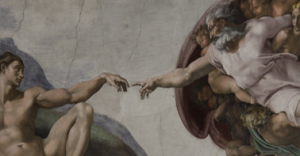
Jesus asked “Who do you say that I am?” Mt.16:15
What is your answer? Who is Jesus for you? We each have an image formed by what we have heard, read, seen in paintings, or perhaps experienced in a mystical way. His physical life on earth took place centuries ago in Palestine, in an obscure village among a people whose language and customs differ greatly to ours. Why is he such a towering figure on the world scene, dividing history? Literally thousands of books have been written, lectures given, sermons preached in an attempt to define him, his universal significance and the mystery around him and his undiminished power to change a life.
Your first impression of Jesus may have been formed as mine was – by story, presenting him as a good, gentle healer and teacher who sadly died on a cross to become our Saviour. Formative as those stories were the images had to be adjusted, or expanded, as life for me became more complex, demanding, perplexing and painful. I imagine this process has been your experience, but I am wondering if the image you presently hold is adequate for the stressful issues to which we are subjected today and the troublesome questions they raise.
In the gospels names are given to Jesus. The names describe how the carpenter from Nazareth was seen by his contemporaries; Rabbi, Teacher, Lord, Messiah, Son of God, Son of David, Beelzebub, King of the Jews, Lamb of God, Christ. No one in Nazareth recognized who he really was – God incarnate in a human body, living among them, sharing their human experience. They shaped their image of God according to their ideas. We have followed the same pattern reflecting him in the mirror of our culture and thinking. We have portrayed Jesus as the promoter of prosperity, the teacher of morals, a leader for justice and human rights, a wise counsellor for peace of mind. There is an element of truth in all these images, but Jesus is much, much more. C. S. Lewis writes: ’A man who was merely a man and said the sort of things Jesus said would not be a great moral teacher. He would be either a lunatic – on a level with the man who says he is a poached egg – or else he would be the Devil of Hell. You must make your choice. You can fall at his feet and call him Lord and God. But let us not come with any patronizing nonsense about his being a great human teacher’.
The mystery of his identity deepens when the name Christ is introduced. This is not his surname; it is his eternal being and divine nature embodied in Jesus of Nazareth. Christ is the ageless, timeless, infinite, universal spirit, transcending death, operating in all spirituality, or divine/human communion. He was from the beginning; maker of the stars who introduced an entirely new dimension of human consciousness. On his journey to Damascus Paul was encountered by Christ, who thereafter became the essence of Paul’s life. Paul said ‘Christ lives in me’, ‘I can do all things in Christ’, ‘In him all things were created’, ‘He is before all things and in him all things hold together’. This is the Cosmic Christ who comes to us today to incorporate us into a life in him; an evolving divine human relationship in which we experience his infinite love and learn the kind of life he wants us to live. How deeply we respond to him is vital.
The enormous cost of incarnation is made vivid in Brennan Manning’s book ‘The Relentless Tenderness of Jesus’. In a passage on the life of Jesus on earth he says ‘The Gospels tell of a man who was cut off in the flower of His age. His work destroyed just when it should have taken root, His friends scattered, His honour broken, His name a laughing stock, one who experienced the nadir of an agony such as no other man or woman has ever dreamed of. No one has ever died as Jesus died, because He was life itself. No one was ever punished for sin as He was – the sinless One. No one ever plunged down the vacuum of evil as did Jesus of Nazareth……the suffering servant, a man who lives as a lackey and dies a disgrace. He is spurned, avoided, treated as a leper, a born loser. He is one stricken by God, publicly beaten, whipped by disgusted righteous society. Eliminate Him, they say; He is distasteful. Drive him out of town, out of society. He is roughly handled, pushed around, taken out, killed and buried among evil doers’. He received all this evil treatment in love – his eternal nature.
He is the One who says “Follow me”, not worship me, or get sentimental about my suffering, but follow me. Learn from him. Live with him and changed by him. I ask myself ‘Have I done that, or have I allowed my image of him to be modified, made-up to look inoffensive, attractive?’ Manning’s image of Jesus throws me out of my comfort zone into shame and silence. Paul’s image of Christ is universal, who is the word of God for us ‘look around at creation, at all things visible and invisible: our lives and the lives around us; the visible world of people, animals, houses, and food; and the invisible world of thoughts and emotions, ideas and feelings. We must look at all this created world, visible and invisible, and realize that Christ is in it. It was created in and through him’, (Eugene Peterson). That is the true, life-changing image we must hold on to.
